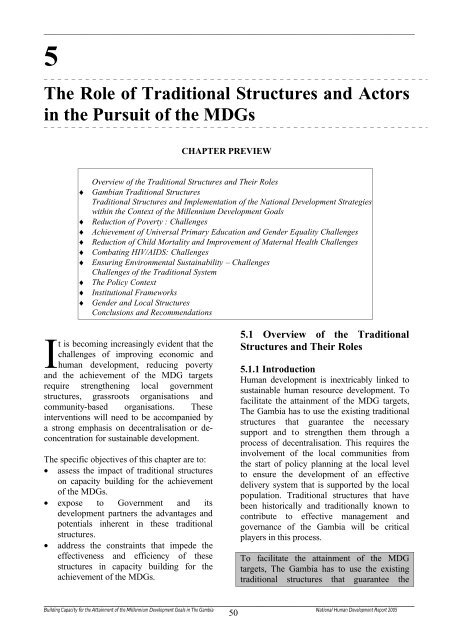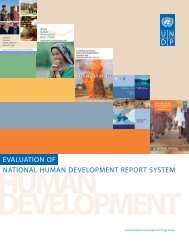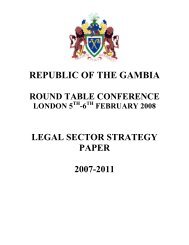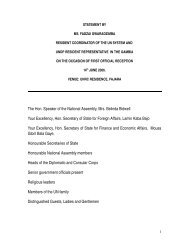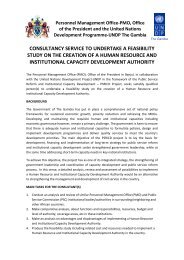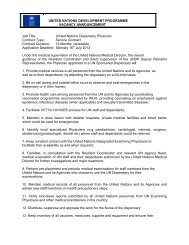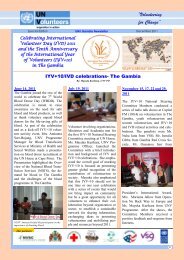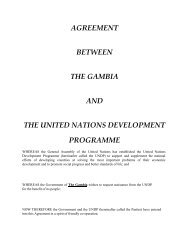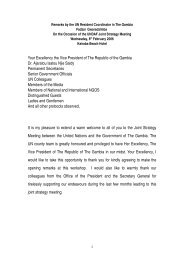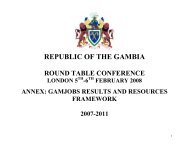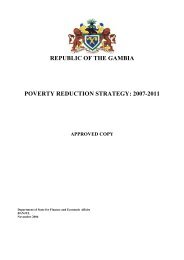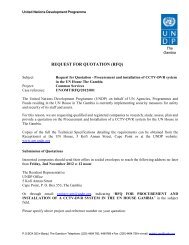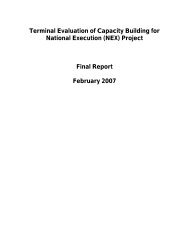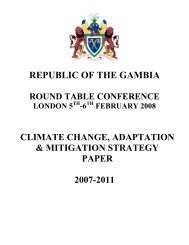Introduction - UNDP The Gambia
Introduction - UNDP The Gambia
Introduction - UNDP The Gambia
You also want an ePaper? Increase the reach of your titles
YUMPU automatically turns print PDFs into web optimized ePapers that Google loves.
________________________________________________________________________________________________________________________<br />
5<br />
<strong>The</strong> Role of Traditional Structures and Actors<br />
in the Pursuit of the MDGs<br />
CHAPTER PREVIEW<br />
Overview of the Traditional Structures and <strong>The</strong>ir Roles<br />
♦ <strong>Gambia</strong>n Traditional Structures<br />
Traditional Structures and Implementation of the National Development Strategies<br />
within the Context of the Millennium Development Goals<br />
♦ Reduction of Poverty : Challenges<br />
♦ Achievement of Universal Primary Education and Gender Equality Challenges<br />
♦ Reduction of Child Mortality and Improvement of Maternal Health Challenges<br />
♦ Combating HIV/AIDS: Challenges<br />
♦ Ensuring Environmental Sustainability – Challenges<br />
Challenges of the Traditional System<br />
♦ <strong>The</strong> Policy Context<br />
♦ Institutional Frameworks<br />
♦ Gender and Local Structures<br />
Conclusions and Recommendations<br />
It is becoming increasingly evident that the<br />
challenges of improving economic and<br />
human development, reducing poverty<br />
and the achievement of the MDG targets<br />
require strengthening local government<br />
structures, grassroots organisations and<br />
community-based organisations. <strong>The</strong>se<br />
interventions will need to be accompanied by<br />
a strong emphasis on decentralisation or deconcentration<br />
for sustainable development.<br />
<strong>The</strong> specific objectives of this chapter are to:<br />
• assess the impact of traditional structures<br />
on capacity building for the achievement<br />
of the MDGs.<br />
• expose to Government and its<br />
development partners the advantages and<br />
potentials inherent in these traditional<br />
structures.<br />
• address the constraints that impede the<br />
effectiveness and efficiency of these<br />
structures in capacity building for the<br />
achievement of the MDGs.<br />
5.1 Overview of the Traditional<br />
Structures and <strong>The</strong>ir Roles<br />
5.1.1 <strong>Introduction</strong><br />
Human development is inextricably linked to<br />
sustainable human resource development. To<br />
facilitate the attainment of the MDG targets,<br />
<strong>The</strong> <strong>Gambia</strong> has to use the existing traditional<br />
structures that guarantee the necessary<br />
support and to strengthen them through a<br />
process of decentralisation. This requires the<br />
involvement of the local communities from<br />
the start of policy planning at the local level<br />
to ensure the development of an effective<br />
delivery system that is supported by the local<br />
population. Traditional structures that have<br />
been historically and traditionally known to<br />
contribute to effective management and<br />
governance of the <strong>Gambia</strong> will be critical<br />
players in this process.<br />
To facilitate the attainment of the MDG<br />
targets, <strong>The</strong> <strong>Gambia</strong> has to use the existing<br />
traditional structures that guarantee the<br />
________________________________________________________________________________________________<br />
Building Capacity for the Attainment of the Millennium Development Goals in <strong>The</strong> <strong>Gambia</strong> National Human Development Report 2005<br />
50


